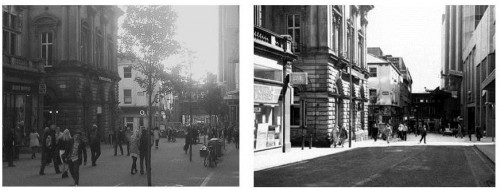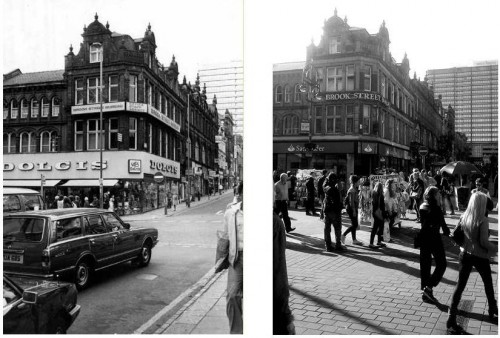
Albion Street 2012 (Pete Z) and in 1980 (Leodis website)
It seems strange and obvious to say that walking is the most popular form of transport, but it’s a point that needs emphasizing, particularly in a transport agenda dominated by tarmac and rail franchises. Our obsession with vehicle based travel has allowed us to forget ‘the glue that holds the transport system together’. This obsession took the country to the brink of designing walking out of much of the transport system: In the 70’s Leeds proclaimed itself ‘the motorway city’ and built roads that severed communities through the heart of the city. Leeds was not alone but its now easy to contrast this with places like York and London where it didn’t happen
Increasingly our communities are dissected and corralled by roads, railways and fences. In planning terms the environment is not porous or permeable and this itself creates an increasing reliance on cars. This is very noticeable in newer estates where journeys to primary schools are often short and easily walkable ‘as the crow flies’ but because the direct route is not possible the ’round the houses’ route is taken which is twice as long. Forcing pedestrians to take the same routes as cars has killed off walking and community life within these estates.
Its only when walking has been designed out of estates and communities we see the real cost to society, as Joni Mitchell wrote in Big Yellow Taxi:
Don’t it always seem to go
That you don’t know what you’ve got
Till it’s gone
They paved paradise
And put up a parking lot
The cost of restitution for walking routes is high, because we don’t put back a little footpath, we tend to pave, tarmac, light and fence off. The loss of walking routes is often because of a change in land ownership, in the examples of new housing estates it’s divided into plots and sold off and walking is designed out. To get walking routes back is likely to involve research, possible legal disputes and potentially buying back the land. Local and national government is good at using their compulsory purchase powers to create roads and public transport routes but this seldom happens for walking (cycling or horse riding) routes.
When it comes to paying for new walking infrastructure there is now an understanding that footfall in town centres = money; the business case for pedestrianisation has been successfully made in city and town centres. The ambiance and sense of place has also become important so larger squares and public spaces are now more common place and public art investment has become more popular. Across Yorkshire the city centres have become shopping havens, it started with the footstreets in York but has now spread well beyond just the tourist economy. Few can now remember back to when Briggate in Leeds had over 50,000 vehicle movements a day; for most days it is a sea of pedestrians, far more than ever fitted on the pavements or in the cars parking there.
Albion Place j/w Briggate 1979 (Leodis) and 2012 (Pete Z)
Although walking is well catered for in the city centres as we move out the conditions become progressively worse. In newer and better planned cities across the world urban planning has begun to make the pedestrian environment better, but the sheer volume of the problem has not really been quantified. Narrow, poorly surfaced pavements with bus stops, bins, lampposts, gaurdrailings and parked cars blocking the way.
The transport investment in our communities is often unambitious and governed by re-surfacing the existing roads, putting in dropped kerbs and bus stops and generally trying to keep everyone happy. However because the majority form of transport seldom speaks with one clear voice, walking is sidelined marginalised (literally) and put on the too difficult pile. If we were to spend a fraction of the money spent on keeping the space where we park our cars tarmacked on imaginative projects to promote walking it would transform our communities. Although most people believe that the road in front of their house is ‘theirs’ to park on, it is in fact public space owned an operated by the council (except on a few private roads).
The most popular public footpaths and bridleways are generally kept clear but there are a myriad of forgotten or less used rights of way that are slowly declining into disrepair. All too often the adjacent landowners erect fences and walls which make the paths next to useless or in some cases the old permissions are lost and the rights of way cut off. The paranoid fear of crime has led to the ‘secure by design’ advice which leads to new estates being fenced and gated and some back streets are ‘alleygated’. Often this is council or publicly owned space and so the authorities that are advising us to be more active and walk are responsible for the removal of direct routes and the lack of permeability that makes walking work.
Transport professionals are now far more likely to concentrate on ‘the first mile’ as nearly every journey involves a portion of walking. The ‘last mile’ is more likely to be better catered for and destination based travel planning measures can more easily cater for the volumes of pedestrians. In some cases community street audits have been used to highlight that problems walkers face and rectify them. Also fuel prices and congestion have made increasing numbers vote with their feet and go back to walking at least a portion of their journey. In the cities we are increasingly likely to see smartly dressed workers wearing trainers for their commute. However it still remains the case that the most popular form of transport attracts the least investment.
This is your chance to send us your own before and after photos, or pics of walking issues and problems…
Like
